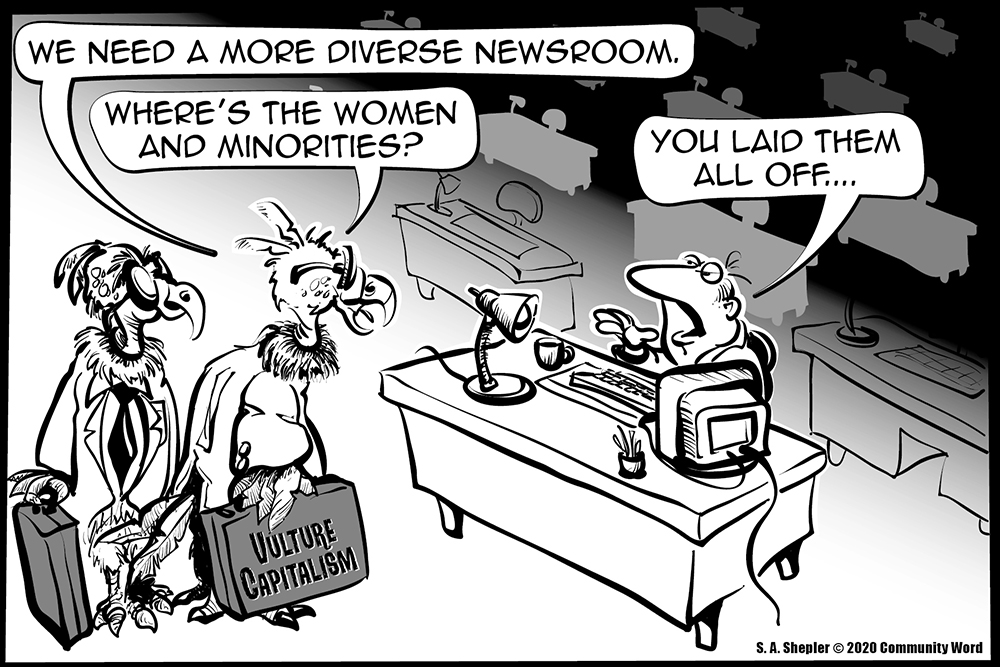
Newsrooms across the country are conducting diversity training and seeking to hire a more diverse staff to improve journalism and report more inclusively on the entire community.
Gannett, owner of the Journal Star, stated it’s making a concerted effort to employ a more diverse news staff. There is a backstory to that.
While news corporations seek diversity, President Trump is attacking diversity training as “a sickness,” “anti-American propaganda” and “un-American.” He ordered cancellation of funding for all federal government programs that teach diversity, white privilege and critical race theory. He has threatened to defund schools that include in their curriculums the Pulitzer Prize-winning New York Times “1619 Project” that views the founding of America not in 1776 and the Declaration of Independence but in 1619 with the arrival of enslaved people.
The Rev. Dr. William Barber, co-chairman of The Poor People’s Campaign, spoke at a National Press Foundation webinar recently and said issues of poverty are intersectional with racism, environmental injustice, denial of health care and the global war economy and should receive more extensive coverage. These are all moral issues created by public policy.
America is becoming a nation with almost 50% of the population in poverty or in low-wage jobs. This is deliberate, and journalism should clearly articulate these issues, he said, noting that 23 million poor and low-income people who are eligible to vote do not vote. Just a portion of those votes would change the moral agenda of Congress, but voter suppression strategically targets poor and low-income people.
Barber said white evangelical religious nationalism is a “slave holder religion,” and it’s “a lie” to contend America doesn’t have the money to end poverty and racism.
“Poverty is done by design. When there is push against women’s right to choose, that’s all about money and marginalization,” he said.
Journalists must put poverty and all its intersectional issues front and center of the political campaigns. Yet in more than 30 presidential debates since 2016, there has not been a specific question about how a candidate would address poverty.
“Why do we have more guns than jobs? Why more money for prisons than schools? This is the policy of violence,” Barber said, asserting that voter suppression is a purely racist policy.
Among the states with racist voter suppression, every one is low wage, high poverty, anti labor rights, he said.
These issues of inequality undermine the future survival of America.
“Poverty will always keep our economy unstable,” Barber said.
In his talk, he never blamed aging, white newsroom staffers. He said journalists have to tell these critical stories about racist public policy by giving voice to those most hurt by immoral public policy.
Another recent webinar hosted by the National Press Club focused on improving coverage of systemic racism.
Journalists are truth-tellers or truth distorters. There is no unbiased, neutral way to report on racism. Reportage is binary –– through a lens of racism or anti-racism. Objectivity and neutrality are constructs that mask inequality.
At its best, journalism is research to find answers to what we don’t know. It is not a process of stenography recording experts and authorities and people in power.
Good journalism is collaborative. We need more people of color in newsrooms, and we have to support good work coming from the newsrooms we have.
Why does the Journal Star newsroom lack racial, sexual and age diversity? Largely because of corporate ownership.
At one time about a decade ago, there were 100 journalists at the newspaper. Then, through a series of corporate takeovers and the relentless pressure to increase quarterly returns, the corporate owners started laying off journalists without cause. Positions were eliminated. In a number of incidents, people working hard were abruptly escorted out of the newsroom. Often, that meant if they wanted to return to collect their personal possessions, they were escorted in and escorted out by a guard. Once-valued employees who had been treated shabbily were no longer trusted.
Because the union contract mandates that layoffs without cause must start with those with least seniority, that lopped off people at the paper 20 years or less. Pensions were cut and benefits were reduced. In fact, at one time, there was no active pension benefit.
Before the corporate layoffs, the paper had some African American journalists who either aged out and retired or left for better jobs. Corporate owners also instituted hiring freezes. And most recently, all newsroom staff was forced to take week-long furloughs each month for three months or longer.
Demands that the six remaining journalists do better work should be viewed in the context that those six are scrambling to get work done that was once covered by 100. And those six are the ones who stayed and endured through horrible management decisions.
A more diverse newsroom is important and would be good for Peoria. But any serious effort to create a more diverse newsroom won’t come from holding the current newsroom up for public ridicule. It will come from valuing good work, starting to put more resources into the newsroom rather than continuing the relentless cutting, and it will come by seeking additional journalists with diverse backgrounds and ethnicities who want to join a vibrant, energized and valued newsroom team.
